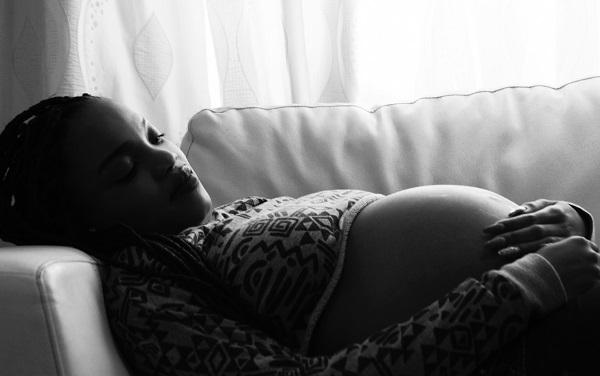
What causes incontinence during pregnancy?
There are many causes for incontinence during pregnancy and postpartum. Some of the proposed factors are:
- hormonal changes,
- pelvic floor muscle and connective tissue modifications,
- bladder neck widening (due to the weight of both the uterus and the growing fetus),
- anatomical injuries during delivery.1, 2
A hormone called relaxin is produced during pregnancy to help soften the muscles and ligaments in preparation for delivery. As the uterus and baby grow throughout pregnancy more load is placed on the pelvic floor muscles causing the pelvic floor muscles to become weaker.3 Also constipation, which is commonly seen in pregnancy, puts an additional load on the pelvic floor.4 Furthermore, the pelvic floor has additional strain placed on it during labor; the pelvic floor muscle is stretched five times its original length.5
 Solutions for Urinary Incontinence During Pregnancy
Solutions for Urinary Incontinence During Pregnancy
Research supports the use of pelvic floor muscle training (PFMT) in the treatment of urinary incontinence during pregnancy and after. PFMT is a voluntary contraction of the pelvic floor muscles consisting of repetitions and sets. PFMT typically is progressed into a maintenance program after 6-12 weeks of training.6, 7 PFMT has been shown to reduce urinary incontinence in late pregnancy and in the early postpartum period, and up to six months after delivery.8
In another study, 113 healthy pregnant women with and without SUI were recruited. Group-supervised exercise sessions were held three times/week for 6 weeks and included a warm-up phase, an aerobic portion with music, strength conditioning exercises, and isolated PFM exercises. A test to measure the electrical activity in the muscles was conducted before and after the six-week training program. They tested quick contractions, 10-second hold contractions, and rest after a 10-second contraction. Initially, the group that was experiencing stress urinary incontinence had the lowest values of pelvic floor electrical activity with quick flicks.
After the six-week training program, the same group showed the highest increase in quick contraction.9 Many of the studies that have looked at long-term follow-up have shown that the benefits of PFMT decrease if a maintenance program is not in place.
How is PFMT effective in the treatment and prevention of urinary incontinence during pregnancy and postpartum?
One mechanism is by increasing muscle volume elevates the pelvic floor muscles and pelvic organs closes the levator hiatus (the opening for the urethra, vagina, and rectum) and elevates the resting position of the bladder. These changes improve the support of the pelvic floor during pregnancy by helping to counteract the increased pressure caused by the growing baby.
It is also proposed that a muscle that is stronger is less prone to injury and has a greater reserve of strength. If the muscle or nerve is injured it will have less loss of muscle function. It is also believed that if the muscle is damaged there will be quicker recovery if there were previous neural pathways for that motor program.6
PFMT may be delivered to women for both prevention and treatment of urinary incontinence and may be started both during pregnancy and after childbirth. If you are experiencing urinary incontinence or want to take preventative measures make an appointment with a pelvic health therapist for an evaluation. Contact our office for an in-person or telehealth session.
References
- Sievert KD, Amend B, Toomey PA et al (2012) Can we prevent incontinence? ICI-RS 2011. Neurourol Urodyn 31:390–399
- Herbert J (2009) Pregnancy and childbirth: the effects on pelvic floor muscles. Nurs Times 105:38–41
- Day J, Goad K (2010) Recovery of the pelvic floor after pregnancy and childbirth. Br J Midwifery 18:51–53
- Marshall K, Thompson K, Walsh D et al (1998) Incidence of urinary incontinence and constipation during pregnancy and post-partum: survey of current findings at the Rotunda Lying-in hospital. Br J Obstet Gynaeco 105:400–402
- Hoyte L, Damaser MS, Warfeld SK et al (2008) Quantity and distribution of levator ani stretch during simulated vaginal childbirth. Am J Obstet Gynecol 199:198.e1–198.e5
- Bø K (2004) Pelvic floor muscle training is effective in treatment of female stress urinary incontinence, but how does it work? Int Urogynecol J Pelvic Floor Dysfunct 15:76–84
- Mørkved S, Bø K (2014) Effect of pelvic floor muscle training during pregnancy and after childbirth on prevention and treatment of urinary incontinence: a systematic review. Br J Sports Med 48:299–310
- Woodley SJ, Boyle R, Cody JD et al (2017) Pelvic floor muscle training for prevention and treatment of urinary and faecal incontinence in antenatal and postnatal women. Cochrane Database Syst Rev 12:CD007471
- Dornowski M, Sawicki P, Wilczyńska D et al (2018) Six-week pelvic floor muscle activity (sEMG) training in pregnant women as prevention of stress urinary incontinence. Med Sci Monit 24:5653–5659
More Articles in This Series
{modulepos position=”postpartum”}
